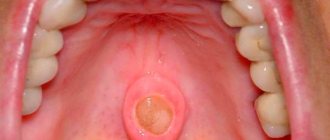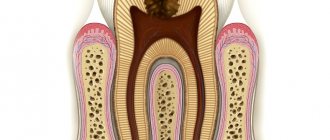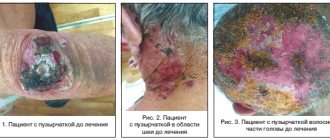Polyp in the ear
Benign polyps of the ear include polyps.
These are neoplasms that arise as a result of the proliferation of granulation tissue. The polyp may be located in the external auditory canal or middle ear. Neoplasms localized in the ears can spread to other parts of the skull. Most often, a polyp is a complication of a chronic inflammatory process in the ear. At the site of chronic inflammation of the mucous membrane, a gradual proliferation of tissue occurs, replacing normal tissue with connective tissue.” into the external auditory canal through the perforation of the eardrum.
A polyp in the ear is manifested by the following symptoms:
- Suppuration, sometimes mixed with blood (stopping the flow of pus can be caused by blockage of the ear canal by a polyp);
- Itching, noise and pain in the ear;
- A feeling of constriction, the presence of a foreign body in the ear cavity;
- Decreased or loss of hearing;
- Headaches.
In the absence of adequate treatment, a polyp caused by an infection in the ear often becomes the cause of chronic otitis media, supports the inflammatory process and prevents the penetration of drugs to the site of infection. The growth of the polyp leads to blockage of the ear canal and deafness. Under certain conditions, there is a risk of its degeneration into a malignant tumor.
For polyps of small size, in some cases, otolaryngologists carry out conservative treatment with creams containing glucocorticoids and antibacterial drops. If the disease is fungal in nature, antifungal drugs are used. The main treatment for a polyp in the ear is surgery.
The polyp is cut off on an outpatient basis with a special loop or using another instrument: a curette, an ear conchotome. Radical surgery is performed in a hospital. The operation is performed if the fistula is localized in the semicircular canal. An alternative treatment option is laser removal of polyps.
Causes
The etiology of ear cancer is studied by specialists from all over the world to this day. Scientists have put forward a theory that the oncological process develops under the influence of cancer viruses, which lead to DNA mutation. However, this assumption was only partially confirmed. Researchers have named the main factors that contribute to the formation of squamous cell ear cancer:
- the presence of chronic pathologies (otitis media, eczema);
- genetic predisposition;
- polyps;
- regular contact with aggressive carcinogens (alkalis, acids, heavy metals);
- inflammation of connective tissue.
It has been established that people who work in enterprises with radioactive radiation are most often exposed to the development of ear cancer.
Glomus tumor of the middle ear
Tympanic paraganglioma (glomus tumor of the middle ear) develops from glomus bodies, which are located on the medial wall or roof of the tympanic cavity, jugular - on the bulb of the jugular vein. Paraganglioma is a benign neoplasm, but mature forms of the tumor have infiltrating and locally destructive growth.
Due to the impossibility of total removal, a glomus tumor of the middle ear can pathologically spread to vital structures of the body (brain stem, internal carotid artery).
Patients complain of a “pulsating” noise in the ear. During an objective examination behind the eardrum, the doctor sees a pulsating red mass. As the tumor grows, the following symptoms occur:
- Hearing impairment;
- Facial asymmetry;
- Dysphonia (speech disorder);
- Dysphagia (swallowing disorder).
If the glomus tumor of the middle ear is widespread, angiography is mandatory. The study is necessary to confirm the vascular nature of the neoplasm, determine its size, location and sources of blood supply.
This plays a role in the possibility of embolization, a minimally invasive procedure that is an alternative to surgery. The procedure is aimed at preventing blood supply to the damaged area, which helps to reduce the size of the tumor and achieve a good effect with further surgical removal of the identified tumor.
Treatment consists of surgical removal of the glomus tumor of the middle ear. Total surgery is performed in the presence of a glomus tumor that does not spread beyond the middle ear. For subtotal (incomplete) removal of the tumor, and depending on the patient’s age, radiation therapy or stereotactic radiotherapy (gamma knife) is used.
Possible complications
If an unpleasant symptom occurs, you should immediately contact your dentist. You should not postpone your visit, since the problem itself will not disappear, but may only get worse. Only a specialist can tell you what to do. In order to make an accurate diagnosis, a computed tomography scan is prescribed. If the doctor excludes the presence of dental problems, the patient will be referred to another specialist (neurologist, oncologist, phlebologist, etc.). Lack of help for muscle tension can lead to the following problems:
- the appearance of back pain;
- dizziness;
- sleep disorders;
- blurred vision, pain in the eyes;
- increased sensitivity to light;
- depressive state.
If the discomfort is accompanied by congestion in the ear, there is a risk of partially or completely losing hearing. When the jaw does not open completely, it shifts. It becomes painful to chew. After some time, problems with teeth arise, enamel wears off, and sensitivity increases.
Benign tumors of the ear
Benign tumors of the middle ear include hemangioma and various neurogenic neoplasms. Hemangiomas of the middle ear are manifested by the following symptoms:
- Decreased hearing;
- Ear congestion;
- Feeling of noise.
Often the first symptom of the disease is a slowly occurring paralysis of the facial muscles on the side where the hemangioma is located. For middle ear hemangioma, otolaryngologists usually perform abdominal surgery or widely remove the mastoid process.
Chemodectoma of the middle ear develops from glomus bodies, which are normally located at the bottom of the tympanic cavity, on the dome of the bulb of the internal jugular vein and in the temporal bone. They differ in structure from glomus bodies, which are located in other areas. Depending on the histological structure and the ratio of cell accumulations, there are 3 types of glomus tumors: adenoid-like, alveolar and angioma-like. According to the clinical course, limited and widespread forms of chemodectoma are distinguished.
Diagnosis of chemodectoma is carried out using radiography of the jugular fossa, pyramid of the temporal bone, attic-antral region, mastoid process. X-ray examination includes radiography of the temporal bone in three main projections and tomography in direct and lateral projections.
Chemodect treatment is surgical. Small tumors that do not destroy the eardrum are removed or exposed to ultra-low temperatures. Tumors that have spread to the external auditory canal, mastoid process, or antrum are also subject to surgical treatment. Otolaryngologists perform operations of varying scope - from tympanotomy to extended radical surgical interventions on the ear. Sometimes cryotherapy is used. For tumors that destroy the pyramid and spread into the cranial cavity, external gamma irradiation is performed, which often causes growth arrest or a decrease in chemodectoma.
General information
Oncology of the auricle is a less common type of pathology, however, we should not forget the threat it can pose. In 85-90% of cases, tumors are localized on the auricle and in approximately 10-15% the tumor is localized in the middle ear.
Among the most common benign tumors of the outer ear are fibromas and papillomas , and more rare ones are chondromas , lipomas and angiomas . Malignant formations are represented by sarcomas (oncology is more often diagnosed in children) and directly cancerous tumors ( carcinomas , melanoblastomas ), which are more susceptible to adults and elderly people.
Osteoma in the ear
Osteoma in the ear (exostosis, osteophyte) develops mainly from the compact layer of the posterior wall of the bony part of the external auditory canal. Much less often, neoplasms are found on the lower and upper walls of this section. Endophytic osteomas penetrate into the mastoid process. Osteoma is a benign tumor that grows rather slowly.
Osteoma has the appearance of a round formation, which is covered with a skin layer, very dense when palpated with a Vojacek probe. It is treated surgically. The operation is performed after the tumor has grown to medium size. In this case, removing the tumor is technically as convenient as possible. If the tumor is small, there is a risk of not completely removing the pathological tissue. If the osteoma is large, it is possible to capture a significant part of the healthy bone tissue during surgery. This will cause a large bone defect.
Lipoma and atheroma behind the ear
The area of skin around the ear contains a huge number of sebaceous glands. For this reason, lipomas and atheromas often form behind the ear. Lipomas that form behind the ear grow slowly and are often not cancerous. They are a soft-elastic formation with a smooth surface, surrounded by a capsule. The lipoma in the photo looks like a wen.
Atheroma is a cavity formation filled with sebum. Formed due to blockage of the sebaceous glands. Atheromas occur for the following reasons:
- Disorders of fat or carbohydrate metabolism;
- Genetic predisposition to increased oily skin;
- Hormonal imbalances and diseases of the endocrine system;
- Hyperhidrosis is a disease associated with excessive sweating;
- Failure to comply with personal hygiene rules.
Atheroma is a rounded formation protruding above the surface of the skin, which can reach up to 4.5 cm in diameter. When the tumor becomes infected or inflammatory reactions occur, the following symptoms occur:
- Pain behind the ear;
- Redness of the skin;
- Burning and itching;
- Fluctuation is a symptom that indicates the presence of fluid in a cavity formation.
When pressure is applied to the walls of the atheroma or they are damaged, the viscous mass contained inside comes out to the surface of the skin. It has a white color and an unpleasant odor. When atheroma suppurates, the contents have a green-yellow tint. Lipomas and atheromas behind the ear are removed surgically. Modern treatment methods are used - laser or radio wave removal.
Salivary gland adenoma is a benign formation that appears in the glandular epithelium of the salivary glands. The salivary glands are parotid, submandibular, and sublingual. The most common occurrence of tumors is on the parotid gland. If the components of such a tumor are benign, then it is an adenoma of the parotid salivary gland.
Effective medical assistance
Seeking help from a doctor if you have a lump on your head near your ear is the best decision. First of all, he finds the starting point and finds out whether the patient has any diseases, since the formation of a lump can be affected by:
- infection getting under the skin. Most often this happens due to an unprofessional puncture of the earlobe or ear cartilage from behind;
- development of a chronic disease, such as diabetes, etc.;
- increased production of sebaceous glands;
- weakened immune system;
- increased sweating.
Adenoma behind the ear
A benign tumor, a parotid adenoma, often develops in the parotid region. The structure of the neoplasm resembles the salivary gland itself. The cause of the development of benign tumors of the salivary glands is the formation of altered glandular epithelium.
The neoplasm is enclosed in a capsule, has a soft-elastic consistency, and is not fused to the skin and surrounding tissues. The skin above the adenoma behind the ear is not changed. It is treated surgically. In order to undergo examination and treatment of benign tumors of the ear and parotid region, call the contact center of the Yusupov Hospital.
Mumps
Mumps can also cause a tumor. It is the salivary glands located next to the ears that have become inflamed, which means they have noticeably increased in size. At the same time, the patient, and these are mainly children, experience an inflammatory process of the throat mucosa, an increase in temperature and a general weak condition. This disease, which has a popular name - “mumps”, is accompanied by painful manifestations in the affected areas. The danger of mumps is that it is transmitted by airborne droplets, and the infection easily spreads to a healthy person. Therefore, complete isolation of the patient is required.










